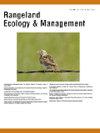多样的本土植物群落是板栗腹鳞鹌鹑重要的筑巢栖息地
IF 2.4
3区 环境科学与生态学
Q2 ECOLOGY
引用次数: 0
摘要
美国德克萨斯州南部栗腹鳞鹌鹑(Callipepla squamata castanogastris)数量的减少与栖息地的丧失和破碎化有关。尽管已知栗腹鳞鹌鹑亚种与本地刺树的总体亲缘关系,但对其特定栖息地需求的研究较少,而且没有关于其人口统计学的信息。我们在德克萨斯州南部进行了一项研究(n = 5个牧场;LaSalle和McMullen县)1)量化板栗腹鳞鹌鹑的生存、繁殖和占用;2)描述其筑巢栖息地的特征,以帮助未来的牧场管理。在2013年3 - 8月和2014年8月,我们捕获并捕获了无线电颈圈的个体(n = 137),以估计其存活率和繁殖率,并在这两年的5 - 8月进行了呼叫计数调查(n = 60点),以估计其占用率和检测概率。我们测量了巢址(n = 53个巢)的植被特征,并对随机点进行配对,以记录栖息地的使用情况。我们记录了季节性存活率(0.68-0.85),窝卵数(10-11个蛋)和明显的筑巢成功率(38-59%),这些值在其地理分布的其他部分范围内。相对丰度较低(0.14 ~ 0.25只/点),占用率较低(0.56 ~ 0.73只/点),检测概率较低(0.10 ~ 0.32只/点)。在筑巢生境方面,刺梨(Opuntia engelmannii Salm-Dyck ex Engelm.)是最常见的筑巢基质(68%;n = 53个巢),刺梨(95% CI β = 0.992-1.105;P & lt;0.09),木本植物(95% CI β = 1.001-1.042;P & lt;0.04),原生草(95% CI β = 0.993-1.129;P & lt;0.08)是区分巢穴与随机地点的重要变量。非原生草覆盖对巢存活率有负面影响(95% CI β = -0.115 ~ -0.006)。如果保护栗腹鳞鹌鹑是一个目标,那么在规划德克萨斯州南部的灌木丛管理时,应高度考虑保护不同的灌木和原生草群落。本文章由计算机程序翻译,如有差异,请以英文原文为准。
Diverse, Native-Plant Communities as Important Nesting Habitat for Chestnut-Bellied Scaled Quail
Habitat loss and fragmentation have been implicated in the decline of chestnut-bellied scaled quail (Callipepla squamata castanogastris) in southern Texas, U.S.A. Although a general affinity of the subspecies for native thornscrub is known, its specific habitat requirements are less studied, and no information exists regarding its demography. We conducted a study in southern Texas (n = 5 ranches; LaSalle and McMullen counties) to 1) quantify survival, reproduction, and occupancy of chestnut-bellied scaled quail and 2) characterize its nesting habitat to help inform future rangeland management. We captured and radio-collared individuals (n = 137) during Mar‒Aug 2013 and 2014 to estimate survival and reproduction and conducted call-count surveys (n = 60 points) during May‒August of both years to estimate occupancy and detection probability. We measured vegetation characteristics at nest sites (n = 53 nests) and paired random points to document habitat use. We documented seasonal survival (0.68‒0.85), clutch size (10‒11 eggs), and apparent nest success (38‒59%) that were within values reported for scaled quail in other portions of its geographic distribution. However, relative abundance was low (0.14‒0.25 calling males/point), as was occupancy (0.56‒0.73) and probability of detection (0.10‒0.32). Regarding nesting habitat, pricklypear (Opuntia engelmannii Salm-Dyck ex Engelm.) was the most common nesting substrate (68%; n = 53 nests), with pricklypear (95% CI β = 0.992‒1.105; P < 0.09), woody plants (95% CI β = 1.001‒1.042; P < 0.04), and native grasses (95% CI β = 0.993‒1.129; P < 0.08) being important variables distinguishing nests from random sites. Nest survival was negatively influenced by non-native grass cover (95% CI β = -0.115 to -0.006). Preservation of diverse shrub and native-grass communities should receive high consideration when planning brush management in southern Texas if conservation of chestnut-bellied scaled quail is a goal.
求助全文
通过发布文献求助,成功后即可免费获取论文全文。
去求助
来源期刊

Rangeland Ecology & Management
农林科学-环境科学
CiteScore
4.60
自引率
13.00%
发文量
87
审稿时长
12-24 weeks
期刊介绍:
Rangeland Ecology & Management publishes all topics-including ecology, management, socioeconomic and policy-pertaining to global rangelands. The journal''s mission is to inform academics, ecosystem managers and policy makers of science-based information to promote sound rangeland stewardship. Author submissions are published in five manuscript categories: original research papers, high-profile forum topics, concept syntheses, as well as research and technical notes.
Rangelands represent approximately 50% of the Earth''s land area and provision multiple ecosystem services for large human populations. This expansive and diverse land area functions as coupled human-ecological systems. Knowledge of both social and biophysical system components and their interactions represent the foundation for informed rangeland stewardship. Rangeland Ecology & Management uniquely integrates information from multiple system components to address current and pending challenges confronting global rangelands.
 求助内容:
求助内容: 应助结果提醒方式:
应助结果提醒方式:


